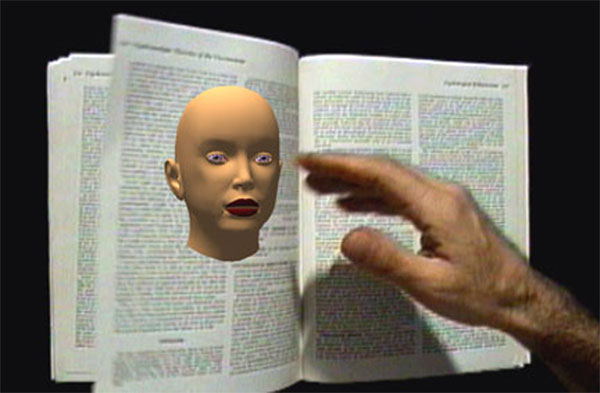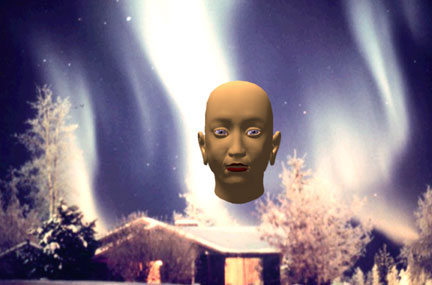

"Pressure to Speak (House of Cards)" emerges from another recent work, "Self Portrait as the Center of the Universe" (2001). Both works belong to a larger series, one in which I have been exploring spaces in which real and virtual imaginaries are bridged. In these works, a large projection appears on one wall of a somewhat darkened room. The central figure is a computer generated realtime animation of a speaking humanlike head, a kind of artificial actor, seen floating against a background of what appears to be a video of landscape or other spaces.
In both works, the projected head is capable of understanding spoken English, and it replies to what it hears (via the software I have developed) with synthesized speech, creating a bridge, in a way, between "physical" and "virtual" spaces. Further, the subject of the conversation, as determined by the artificial actor, controls the landscape which is seen, so these change as the conversations go along, and other figures appear and disappear.
In "Self Portrait", the physical side of the conversation is performed by an animatronic figure (a speaking silicone cast of my head) and the central subjects of their conversation revolve around, on one side – generalization and distance; and on the other – questions and memories of itself. "Pressure ..." circles around the drive to make narrative out of fragmentary experience, and, as its title implies, the pathos of doing so.
The animatronic figure is gone, and there is a microphone (as in my other recent work, "Sinking Feeling" (2001)) standing in the middle of the room. The figure in the projection tries to construct narratives from what it hears, tries to build them up, and eventually loses the thread and starts again, forgetting its story. Whatever is spoken into the microphone engages the figure directly – it will reply, as well as try to continue its imagined story.
But also, recognizing the difficulty of using speech recognition technology to understand clearly in a multilingual context, the head will actually incorporate whatever it thinks it hears, regardless of what was intended. So the fragmentary narratives that will be created change with what is spoken by the audience, in any language at all – and the figure also speaks when he hears nothing, telling stories to itself and drawing visitors into his games about language, memory, and place.
a few text fragments:
"Eight feet, nine eyes, two tails, four mouths. A wise man in the company of wise men, tries to solve this riddle.' This is what he said, over and over. I could never get him to explain this riddle to me."
"One night Humayun was smoking and observing Venus from the roof of his library when he heard a voice call his name from the Bhairon cave. Turning, his foot caught in the folds of his garment and he fell to the bottom of the circular stairs and died."
"If you pay too much attention to your shadow, you are likely to become mad or to be killed by a passing car. But as I put my feet one after the other on those cobblestones in the alleys of the old town I was going in deeper and deeper into it."
"To the north, a crow landed in a tree, and just at that moment, seeing shadow upon shadow, he felt that he finally understood the purpose of this night. He continued to fall, and yet he still felt not a bit of fear, only the inspiration of his own ideas."
"My greatest fear when climbing or descending a circular staircase is that it might be infinite, that its stairs would reproduce exponentially like dividing cells, that it would extend endlessly in both directions and that I would never escape it."
exhibition history:
Seoul Museum of Art; "media_city seoul 2002"; Sept 2002 – Nov 2002
ACE Gallery, Los Angeles; 2005–2006